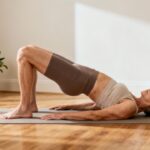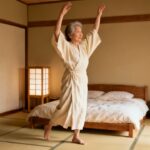If you’ve ever stood up and felt that tight pull in your lower back or heard your knees crack when rising from the couch, you’re not alone. Over 65 million Americans report recent episodes of back pain, and nearly half of those over age 50 say joint stiffness limits their daily movement.
The worst part? Most people think it’s just part of getting older, like gray hair or reading glasses. But here’s the truth: It’s not just age. It’s neglect. And the longer we ignore those early warning signs, the more freedom we give up one movement at a time.
In this article, I’m sharing five no-equipment movements that go deeper than just stretching. These are quiet but powerful ways to unlock your back, restore joint freedom, and reclaim ease in daily movement without pain pills or pricey therapy.
Exercise 1: The Resting Squat – Reclaim Your Natural Strength
Before chairs, we squatted for rest, for work, for life. And now most of us can’t even get into that position without tipping over or groaning in pain.
But here’s the thing: It’s not your age. It’s the years of stiffness silently building up in your hips, ankles, and spine.
The resting squat isn’t a fancy exercise. It’s a return to a posture your body was designed to hold: a full deep squat with heels on the ground, spine upright, and muscles relaxed.
This simple position can unlock everything from tight hips to lower back tension. It decompresses the spine, opens the pelvis, improves ankle mobility, and even resets your nervous system.
How to do it:
- Stand with your feet slightly wider than shoulder width, toes turned out gently
- Sink slowly into a deep squat, keeping your heels flat on the ground
- Let your hips drop as low as they naturally go
- Keep your spine long, chest lifted, and arms in front or resting naturally
If you can’t get all the way down without falling backward, that’s not failure; it’s feedback. Use a sturdy surface like a wall, doorway, or table to support yourself as you ease into the position. Over time, your body will relearn what it once knew.
Start with just 60 seconds a day. You might be surprised what wakes up inside your body and what starts to loosen up with consistency.
And remember, this isn’t about pushing through pain. It’s about reconnecting with a movement your ancestors used daily and your joints are craving today.
Exercise 2: Superman Hold – Wake Up the Backside
Back pain doesn’t start with injury. It starts with neglect. We sit, we slump, we forget we even have muscles back there until they remind us with pain.
The Superman hold is a simple yet powerful way to reactivate your posterior chain, the muscles that support your spine, your posture, and your ability to move pain-free.
That includes your glutes, hamstrings, lower back traps, and core—the entire backside engine.
How to do it:
- Lie face down on a mat or firm surface
- Extend your arms in front of you, legs straight behind
- Slowly lift your arms, chest, and legs off the ground at the same time
- Keep your neck neutral – don’t strain upward
- Squeeze everything – imagine your back muscles becoming one solid piece
- Hold for 10 to 15 seconds, then relax
- Repeat for 5 to 8 slow, controlled reps
This isn’t a flashy move, but it builds real spinal strength, the kind that prevents future pain and improves posture day by day.
And if lying flat is too intense, try the bird dog instead: Kneel on all fours and slowly extend one arm and the opposite leg. It’s a gentler version, but still targets the right muscles.
Your back deserves attention. Start small, but start.
Exercise 3: Single Leg Romanian Deadlift – Balance is the New Strength
Here’s a wake-up call: If you can’t stand on one leg for at least 10 seconds without wobbling, your body is quietly losing its foundation. Balance isn’t just a skill. It’s a vital sign of joint health, core strength, and injury prevention.
The single leg Romanian deadlift (RDL) is one of the most effective movements to target your glutes, hamstrings, lower back, and deep stabilizers, all while teaching your body how to move with grace, not guesswork.
How to do it:
- Stand tall, feet hip-width apart, arms relaxed by your side
- Shift your weight to your right foot
- Begin to hinge at your hips, sending your left leg straight back while your upper body tips forward
- Keep your spine long, shoulders square, and core engaged
- Your back leg and torso should move as one, forming a straight line
- Lower until your torso is nearly parallel to the floor
- Then return slowly to standing
Control is everything. Don’t rush. Don’t reach. Don’t collapse. Do 5 to 8 reps per side for 2 to 3 sets.
This movement doesn’t just build strength; it exposes imbalances. You might notice one leg is shakier or weaker. That’s good information, not failure. It shows you exactly where to focus.
If your balance is shaky, use a wall or chair for light support at first, but aim to do it unassisted. Over time, this move builds coordination, joint resilience, and confidence—the kind that prevents falls and supports every step you take.
Real strength isn’t how much you can lift. It’s how well you control your body when only one leg is on the ground. Start slow. Stay focused. Your joints will thank you.
Exercise 4: Sumo Squat Hold – Power Starts in the Hips
Your hips are the hidden heroes of how you move, stand, sit, and walk. But modern life, with all its sitting, slouching, and stiffness, has robbed us of the mobility and control we once had. That’s where the sumo squat hold comes in.
This wide stance squat isn’t just about building muscle. It’s about restoring space in your hips, reactivating postural muscles, and improving the alignment of your entire lower body. It’s a static hold, but don’t be fooled—your legs will know they’re working.
How to do it:
- Stand with your feet wider than shoulder width, toes turned slightly outward
- Sink your hips down and back as if you’re sitting into a deep squat
- Keep your spine tall, chest lifted, and core gently braced
- Hold this position not with tension, but with control for 30 to 60 seconds
You’ll feel it in your inner thighs, glutes, lower back, and core—a full-body conversation happening below the surface.
This movement helps undo the poor posture caused by long hours in chairs and strengthens the very muscles that keep you upright and moving with ease.
If your knees collapse inward or your heels lift, ease back slightly or use your elbows to gently press your knees open to maintain alignment. And if you’re still building strength, shorten the hold time and build up gradually.
This isn’t just a squat; it’s a powerful stance that trains your body to own its shape from the ground up.
Exercise 5: Knee to Chest Stretch – Gentle But Deeply Effective
Not every movement has to be intense to be transformative. Some of the most powerful shifts in your body happen when you simply let go and create space where there’s been tension for years.
The knee to chest stretch is a quiet but crucial movement, especially for anyone dealing with lower back pain, tight hips, or stiffness from long hours of sitting.
It gently decompresses the lumbar spine, stretches the glutes, and eases tension along the sciatic pathway.
How to do it:
- Lie flat on your back on a mat or firm bed
- Keep your legs extended to start
- Bend your right knee and slowly pull it toward your chest using both hands just below the knee
- Keep your left leg relaxed or bent, whichever feels better for your back
- Breathe deeply and hold for 20 to 30 seconds, then switch sides
You can also bring both knees to your chest for a deeper release. Just listen to your body and stay within a comfortable range.
This is an excellent way to end your movement session. It’s a reset button for your spine, helping everything soften and realign before you move into the rest of your day.
If getting on the floor is difficult, this stretch can be done on a bed. And if lying down isn’t an option, try the seated version: Cross one ankle over the opposite knee while sitting, then lean forward gently. Same principle, same benefits.
Never underestimate simple movements done with intention. Sometimes the body doesn’t need more force; it just needs permission to let go.
Important Safety Considerations
These movements are gentle and designed for most bodies, but not all. If you’re currently dealing with severe lower back pain, sciatica flare-ups, recent surgeries, or diagnosed spinal issues like disc herniation, it’s best to speak with a physical therapist or doctor before trying these exercises.
Pain that shoots down the leg, numbness, or loss of mobility are signals your body needs more than stretching; it needs specific medical care.
And remember, discomfort is okay, but pain is a no-go. If something doesn’t feel right, skip it or modify it.
Movement is medicine, but only when done with awareness and respect for where your body is today.
The Truth About Pain and Movement
Here’s the truth most people don’t want to hear: Pain doesn’t just show up one day out of nowhere. It builds slowly through every hour you spend sitting too long, every step you avoid taking, every stretch you skip because it feels too simple to matter.
But movement isn’t optional. It’s your insurance. Your joints don’t need punishment; they need nourishment.
And these five movements aren’t about burning calories or chasing aesthetics. They’re about reclaiming your right to move freely, stand tall, and live without fear of your own body.
Imagine being able to get out of bed without back pain, to walk upstairs without knee discomfort, to bend, twist, reach, and stretch—not because you’re young, but because you’ve chosen to stay strong and mobile.
It doesn’t take hours a day. It takes consistency, intention, and a decision to start. Maybe you won’t feel a transformation after day one, but give your body time. Each repetition is a message: I still care. I still want to move. I’m not giving up.








